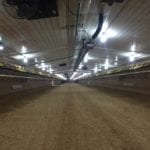
Photometric Flicker and the impact on poultry performance
Photometric Flicker and the impact on poultry performance Photometric flicker is the rapid change in light intensity from a light source and is caused by three effects. The first is light density flicker which is caused by changes to brightness levels caused by a light source such as a bulb, fluorescent tube, or LEDs, powered […]
Read More >
MAIN CAUSES, CONSEQUENCES, AND SOLUTIONS FOR POOR AIR QUALITY
Poor air quality impacts not only animals but also human health and welfare. Gases released by animals and equipment, dust, and airborne microorganisms, when in high concentration, may contribute to the occurrence of diseases. This article will discuss the leading causes, consequences, and solutions for poor air quality in swine production. Gases Ammonia, carbon monoxide […]
Read More >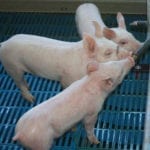
The swine industry recognizes that water requirement intake and flow rate are crucial to pig performance and farm management. Still, water evaluation is frequently based on subjective monitoring of physical properties like smell, color, temperature, and taste. However, water quality also includes chemical and microbiological characteristics that must be considered and assessed. Mineral composition, conductivity, […]
Read More >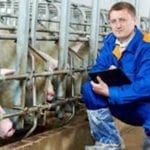
5 Biosecurity Practices Everyone Should Follow
5 Biosecurity Practices Everyone Should Follow Biosecurity refers to procedures used to prevent the introduction and spread of disease-causing organisms in livestock farm sites. We need to undertake biosecurity measures to minimize the risk of disease to livestock, as well as spread of organisms of public health concern such as salmonella and campylobacter. Preventing disease […]
Read More >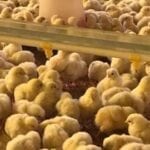
Five Steps to Better Chick Brooding
Five Steps to Better Chick Brooding Improving chick brooding to get new baby chicks off to a good start can impact their growth and performance for their entire time spent on your farm. Chicks require feed and water within 24 hours to jump start their appetite. They also lack the ability to thermoregulate, so we, […]
Read More >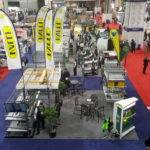
Normally this week of the year we would be wrapping up IPPE and we would be taking this time to showcase again all that we shared with you at the show. But of course, this tradeshow season is a little different. since we couldn’t see you in Atlanta, we didn’t get to share with you […]
Read More >King’s Poultry Farm – Reuben King
Reuben King, a 29-year old poultry farmer and business owner, has made a name for himself in Bradford, OH. For 22 years, Reuben has helped out the family slaughtering chickens. His parents, William and Marilyn King, started raising and processing chickens by hand in the barnyard in 1983. They purchased an automatic picker and fixed […]
Read More >
Feathering’s biggest role is to serve as protection from the elements. It’s an insulation factor that keeps birds’ bodies warm so that energy can be better used to lay eggs or grow muscle tissue. But why do birds lose their feathers? The answer is sometimes complex. Factors range from housing structures and equipment, to nutrition […]
Read More >
This year has certainly been a tumultuous one. It started our normal enough. The International Production & Processing Expo took place in Atlanta, Georgia. We featured our newest addition to the VAL-CO fan line, the variable speed V-Fan. VAL-CO has stepped up to help achieve the ideal environment with the introduction of the versatile, highly […]
Read More >
What we know about woody breast
Woody breast syndrome has been an on-going concern for integrators. It’s not a modern problem; research has shown that it did exist in genetic lines from the 1950s, it was just less noticeable because the condition did not progress far enough. While not detrimental to the birds themselves, it does create a less-than-desirable end product […]
Read More >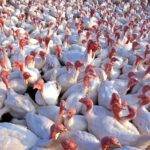
Don’t Let Salmonella Ruin your Holiday
Don’t Let Salmonella Ruin your Holiday When it comes to food safety, everyone has a roll to play. Farmers and integrators often work closely together to ensure that the birds live a healthy life and are processed in sanitary conditions. The entire food chain is designed to reduce salmonella contamination, but let’s face it, the […]
Read More >
Alternative Breeder Management Practices: Male Restaurant Feeding
Alternative Breeder Management Practices: Male Restaurant Feeding Male “restaurant” feeding is a breeder management practice that is utilized by some integrators in certain parts of the world. It is a feeding practice where males are trained to come to the sound of a whistle to enter a separate feeding pen. This allows the males and […]
Read More >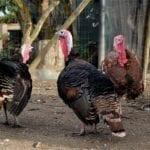
This week we celebrate all that we are thankful for around the traditional roast turkey. But what do you really know about that magnificent bird? The North American Turkey was nearly hunted to extinction by the early 1900s when there was just 30,000 birds left. Today, there are nearly 7 million. The dangly appendage on […]
Read More >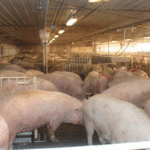
Post-weaning Diarrhea PWD affects pigs in the first two weeks after weaning, commonly characterized by diarrhea, and followed by dehydration, sudden death, and growth delays. Stress factors, including removal from the sow, dietary changes, and new environments and pig groupings, may decrease immune function and lead to intestinal gut dysfunction. PWD is associated with e. […]
Read More >
Signs & Symptoms of Swine Respiratory Disease
Swine Respiratory Disease (SRD) How to recognize the signs and symptoms Swine respiratory diseases are the largest cause of swine casualties in the United States. Often, multiple strands of bacteria are involved which lead to an increased length and harshness. Multiple strands also can cause infected pigs to go untreated or mistreated due to the […]
Read More >
Porcine Circovirus – What is it?
Porcine circovirus – what is it? Porcine circovirus disease (PCVD) is a relatively new viral disease among swine. It’s a very small DNA virus with a circular genome that is hardy in the environment. Originally discovered in 1974, porcine circovirus type 1 (PCV1) was recognized as a non-disease-causing agent that frequently occurred in laboratory tissue […]
Read More >
Radiant brooders have been common-place in poultry houses for many years, and there’s a reason for that. They are great in the south, where there are mild winters and abundant chicken farms. Brooders are easy to install and easy to maintain, as well as being affordable. But there are downsides, as with anything. Improperly serviced […]
Read More >
How Plumage Affects Breeder Productivity
Plumage, or feathering, on chickens serves to provide insulation and protection. When the feathering is compromised, it effects more than just birds’ appearance. Hens with poor plumage struggle to be productive. As an insulator, feathers help birds to maintain their warmth. Balding birds have to consume more feed in order to increase their thermal output. […]
Read More >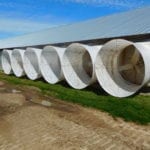
The In Between – Transitional Ventilation
The transitional seasons for ventilation are typically Spring and Fall. These seasons are normally where you are going to have the most fluctuation in temperature making it difficult for growers to ventilate properly. Whether you are transitioning from minimum to full ventilation, or full to minimum ventilation, it is important to regulate temperature changes gradually. […]
Read More >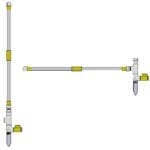
The Val Lott Stick is a great tool to help you measure flow rates through your Val Nipple Drinker System. It’s always important to know exactly how much water is being delivered to your birds, and having a log of flow rates will help you notice problems early on. Water supply, water pressure, dirty or […]
Read More >